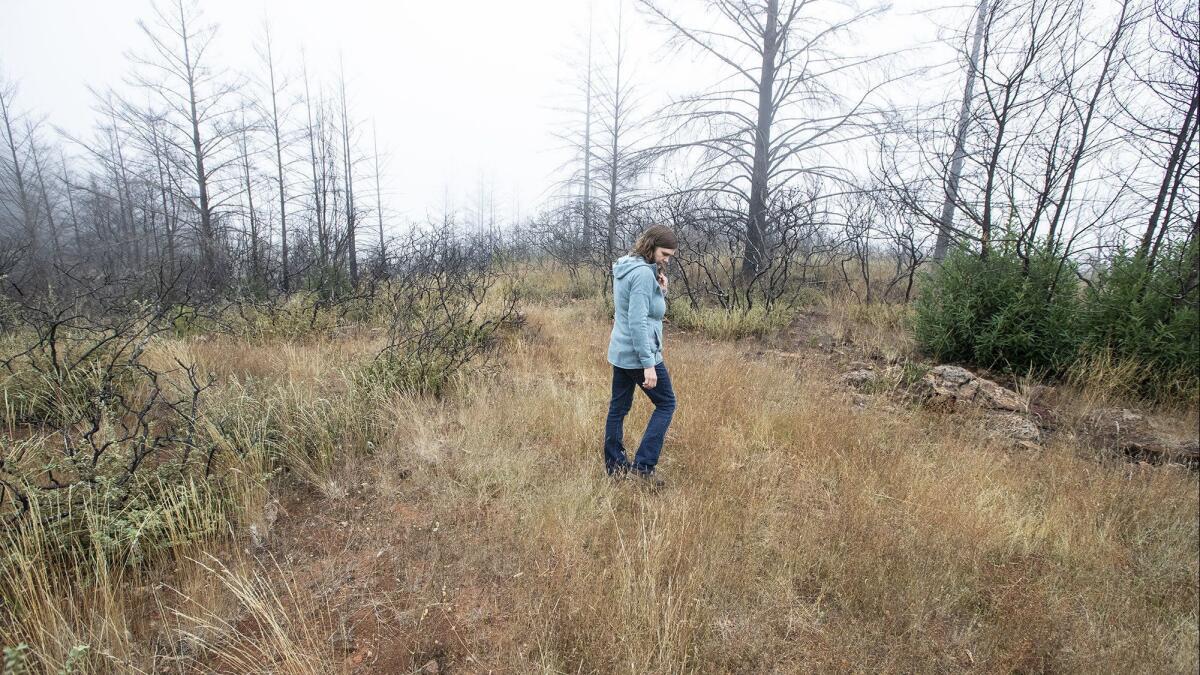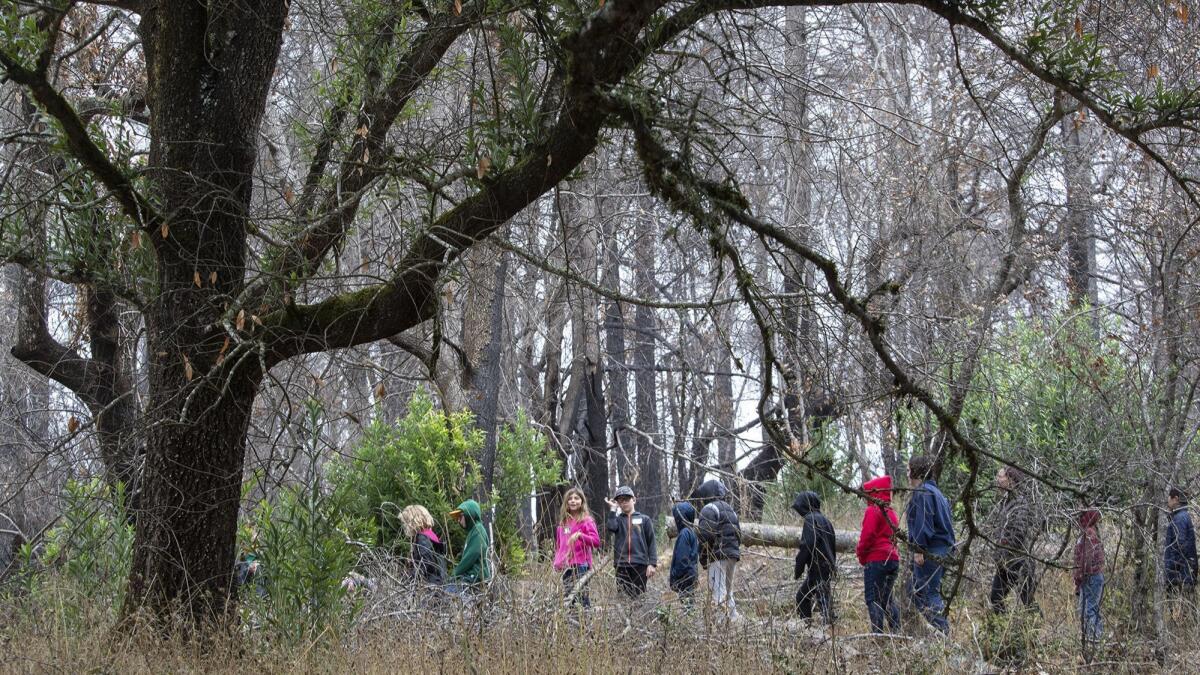As this Sonoma County land preserve heals from the devastating Tubbs fire, so too does its steward

- Share via
Reporting from Santa Rosa — Two weeks after the Tubbs fire tore through Sonoma County, Michelle Halbur drove up the familiar winding road to Pepperwood Preserve so she could see what had become of it.
The weary ecologist knew that the fire had scorched most of the 3,200 acres of protected land just north of Santa Rosa, as well as several buildings on the property. But nothing could prepare her for what greeted her: a charred moonscape dotted with barren trees, and an unearthly silence. No rustling grass, no chirping birds. No traffic from the nearby Mark West Springs neighborhood, where hundreds of homes had burned.
Then something stirred. A deer stood on its hind legs as it foraged for leaves that the flames had not touched. It was a comfort to see a sign of life, however fragile, after so much devastation.
It had been an unbearable week for Halbur, whose in-laws were among the 22 people killed by the fire. She would spend the coming months teetering between grief and joy as she watched nature rebound in the aftermath of California’s most destructive wildfire. She threw herself into her work — not only tending to the land, but using it to study the effects of wildfire and long-term vegetation response to climate change.
A year later, Halbur has found healing in what she’s witnessed.
A few weeks after the fire, green shoots of perennial bunchgrass pushed through the blackened ground. Woody chaparral shrubs had also begun to sprout: chartreuse clumps of chamise, shrubby leaves of coast live oaks.
Growth accelerated throughout the spring with bursts of wildflowers, including some species that hadn’t bloomed there since the ’60s, when the Hanley fire tore through the preserve. There were the blue toadflax, the soft yellow whispering bells, the purple Venus’ looking glass. Scientists call them “ fire followers”; their embryos lie dormant in the soil for decades, waiting for fire to trigger their germination.
The kaleidoscopic display of renewal stood in blunt contrast to the heartbreak Halbur felt outside of work, yet it had its similarities. Recovery, too, comes in fits and starts.
“I was living a dichotomy: I was grieving, I was in pain,” said 40-year-old Halbur, who grew up in Sonoma County. “But I felt so much curiosity over the way that the land was changing.”
Some days, as she’s driving through the fire’s footprint on her way to work, she’s grateful for the opportunity to see the hills and rock formations that were once hidden by Pepperwood’s Douglas firs, hundreds of which are now gone. Then there are days when those hills speak only of loss, days when the sight of a blackened tree trunk or the howl of high winds will trigger memories of the early morning of Oct. 9, 2017.
The night before everything changed, Halbur and her family ate Sunday dinner at her in-laws’ home in Santa Rosa, a weekly tradition. Her father-in-law, LeRoy, talked about how he thought he’d never make it to 80. And yet there he was, a thriving octogenarian. Halbur and her husband, Dave, gave their 2-year-old son a tour of family portraits, explaining who was who in each one.
When they got home, they sat in their driveway for a few minutes and reflected on what a perfect night it had been, down to the unusually delicious Chinese takeout. Then they went inside and went to bed.
Their son, Rowan, woke Halbur up at around 2:30 a.m., seeking comfort after a nightmare. After consoling him, she got a text from a friend: There was a wildfire, a big one. He was being evacuated. “It’s probably just a grass fire,” Halbur thought. She fell back asleep.
At 5 a.m., she heard a pounding on the front door. It was a neighbor, clearly frantic. “There’s fire everywhere,” the neighbor said. “We’re getting out of town.” It was then that Halbur noticed that there were people in the streets, a plume of smoke in the hills.
Because they were in the city’s urban center, they decided not to evacuate. Dave Halbur called his parents, who lived right in the fire’s path. No answer. He spent the morning looking for them, driving from shelter to shelter. By day’s end he would learn that Donna and LeRoy Halbur, both 80 and married for half a century, had died trying to escape.

When Michelle Halbur returned to Pepperwood in mid-October, she carried the immense weight of her loss, but also a sense of responsibility to help future generations learn from what had happened.
“Right away I knew that I was going to have a positive experience professionally,” said Halbur, who works with visiting scholars to research the long-term effects of climate change. “Right away I knew that this landscape would thrive after the fire, that it needed fire. But right away I was absolutely devastated.”
Pepperwood — a nickname for the fragrant California bay laurel, a large shrub that bears an avocado-like fruit — is no stranger to combustion. There is evidence of wildfires manifesting there in 50-year intervals since the 1870s. Before that, the Wappo Native Americans burned the land every five to 15 years to improve crop production.
Halbur regards this history — along with a wealth of research on the matter — as proof that humans should see fire as a tool rather than something that simply happens to them. The preserve’s staff is studying how people might better coexist with fire, an element Sonoma County’s ecosystem has been adapted to for millennia.
With the assistance of a Native advisory council, Pepperwood researchers are experimenting with fire management strategies used by the Wappo people. The staff had begun conducting prescribed burns in the grasslands even before the Tubbs fire, studying fire patterns and various land management practices that will only become more important if the predicted consequences of climate change — more frequent wildfires, among them — come to fruition.
Ideally, this work will help researchers identify which areas are at the greatest risk for wildfire. That knowledge can be used to build more resilient communities, fire detection technology and emergency response protocols.
Halbur thinks about that often — about how, if Santa Rosa had been better prepared for the latest wildfire, she might still be having Sunday night dinners with her in-laws. A steady undercurrent of heartache and hope propels her forward.
Pepperwood also continues to heal. The grasslands, benefiting from soil flush with nitrogen from the plants that burned, are thicker than they were before the fire. Redwood trunks that were scorched beyond recognition are now coated in bright green sprouts.
On the first anniversary of the Tubbs fire, Halbur pointed to a gnarled coast live oak, its branches growing healthy clusters of leaves around an ashen trunk.
“This one’s survived other fires,” she said, touching its bark.
Knowing what she knows, it will probably live through another.

[email protected] | Twitter: @LauraMNewberry
More to Read
Sign up for Essential California
The most important California stories and recommendations in your inbox every morning.
You may occasionally receive promotional content from the Los Angeles Times.











